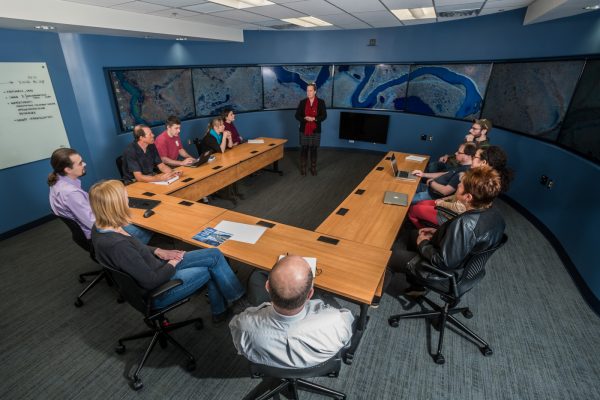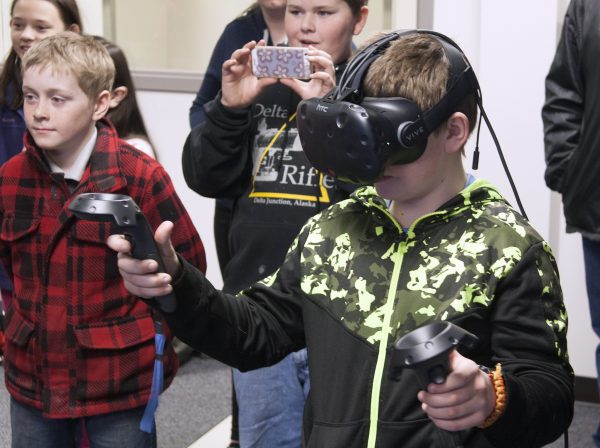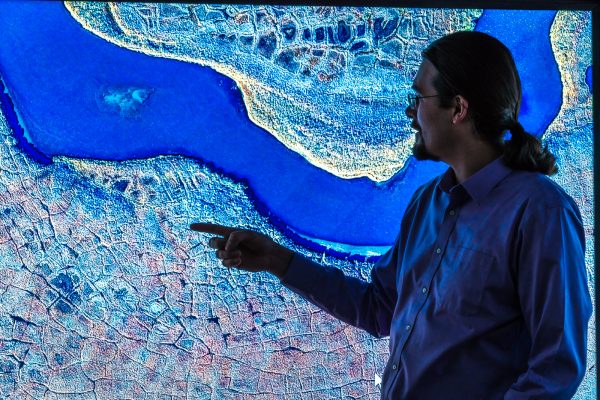UAF's Decision Theater North uses tech to connect
July 6, 2017
Tom Moran
907-474-5581

Download text and photo captions here.
The name “Decision Theater North” is something of a misnomer.
For starters, the newly renovated space in the West Ridge Research Building at the University of Alaska Fairbanks doesn’t often function as a theater, even though its defining features are the seven behemoth screens forming a semicircle along one wall. That’s because the main purpose of the room isn’t presentation, it’s dialogue.
“With the complex problems facing the Arctic and the amount of research we’re doing, we were looking for ways to bring people together to talk about current issues,” said Pips Veazey, the prime mover behind Decision Theater North. “And so this is a space where we can bring together people to talk about complex issues and look at lots of data spread across the 60 million pixels’ worth of screens.”
Veazey, associate project director at Alaska's National Science Foundation-funded Established Program to Stimulate Competitive Research, proposed the theater as a way to present the massive volumes of data in a comprehensible and interactive way. It’s based on similar spaces at Arizona State University and at the McCain Institute in Washington, D.C. In addition to the seven 75-inch screens ringing its conference table, it features audio, a videoconference system, high-speed wi-fi, dedicated memory and a 10-gig link to UAF. As the name suggests, fostering collaboration and decision-making, both within and outside of academia, is the ultimate goal of the room.

“There’s research to suggest that people are more empathetic when they are looking at information on the screen together and discussing it, rather than videoconferencing or calling in to a teleconference,” Veazey said.
Veazey said two recent events have made the fullest use of the theater, which began operating in 2016. The first was a tsunami simulation run in collaboration with Sandia National Laboratories, which demonstrated the potential of merging Sandia software and UAF data to aid in emergency response. More recently, EPSCoR researchers held a workshop with the board of directors of Kuukpik, the corporation of the North Slope village of Nuiqsut, to share EPSCoR work in the area and to identify common research interests. Researchers filled the screens with information and imagery, kick-starting some animated back-and-forths among attendees.
“In Decision Theater North, we are able to come together and talk about the challenges that Alaska and the circumpolar North are facing right now, in a respectful environment that is specifically set up to help people engage with each other and to make data-driven decisions,” Veazey said. “ I think that gets at the essence of what a decision theater is.”
On the other hand, the “Decision Theater” moniker doesn’t fully capture the versatility of the space. It’s been used for dozens of seminars, webinars, trainings, meetings and thesis defenses. It was on display at Arctic Science Summit Week in 2016 and Week of the Arctic a year later, and in May it displayed the winners of an EPSCoR-sponsored visualization contest at its first-ever First Friday. The Federal Emergency Management Agency brought in 35 people from different agencies for a disaster simulation, and the American Red Cross roped in a dozen to take part in a map-athon event where they contributed content to Open Street Maps.

“It’s almost like this excuse to bring people together here,” Veazey enthused. “We have this space, how can we use it to serve our community, whether it’s Fairbanks or the state of Alaska or the circumpolar North?”
The space was funded by UAF and by EPSCoR, a program which bolsters Alaska’s scientific capacity by supporting interdisciplinary research projects as well as education and infrastructure. It’s maintained and operated by EPSCoR with assistance from the Geographic Information Network of Alaska, and the UAF Office of Information Technology. It’s also spurred the creation of a developmental room across the hall, which began life as a place to program content for the theater, but has grown to include new technology for visualizing and sharing data, including a 360-degree camera, virtual reality gear and a 3D printer.
For more information, visit http://www.dtn.alaska.edu/.


